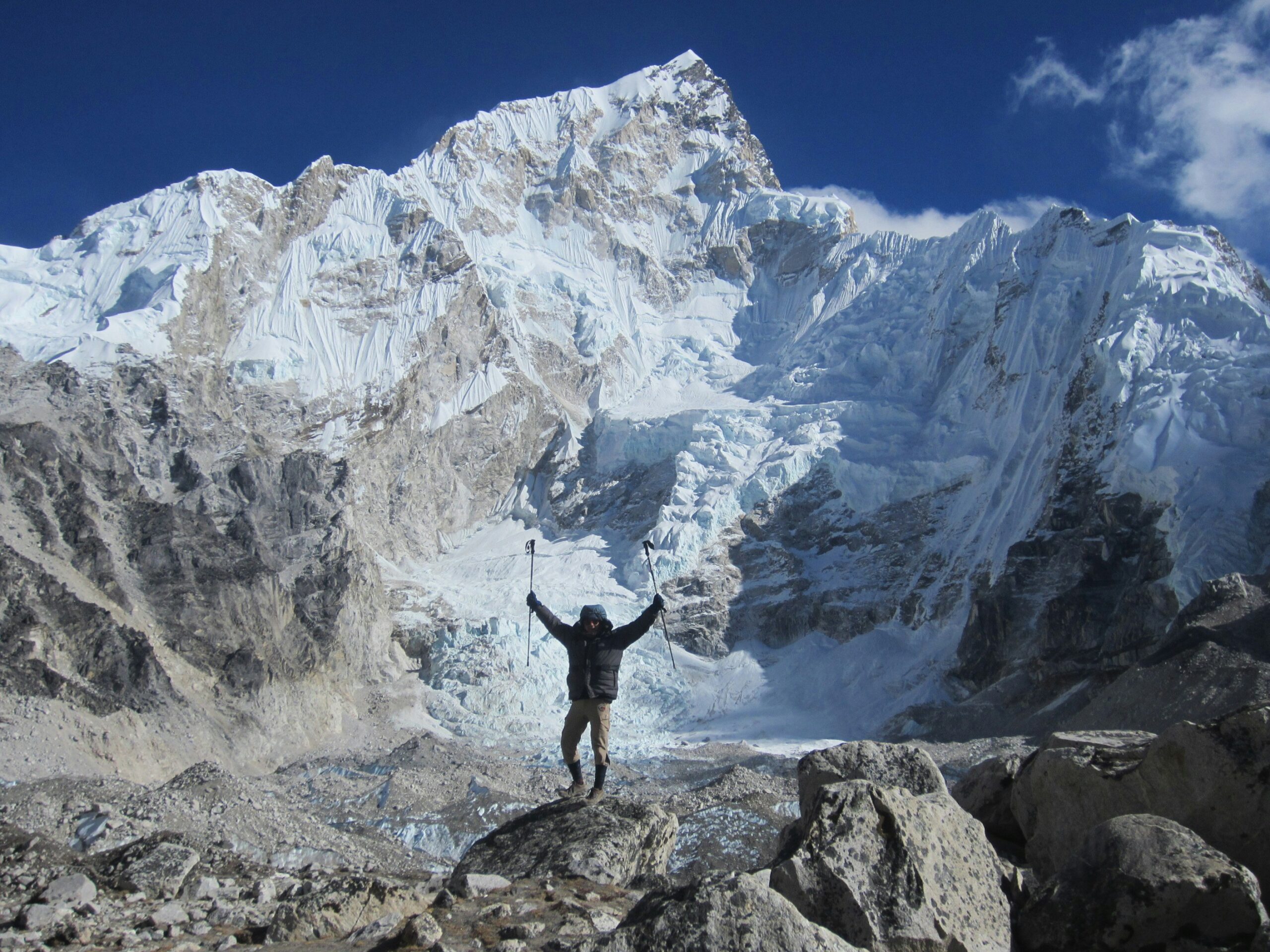
The Everest Base Camp Trek is one of the most iconic and unforgettable adventures on the planet. This legendary trail takes you deep into the heart of the Himalayas, winding through Sagarmatha National Park, traditional Sherpa villages, and awe-inspiring alpine landscapes. Reaching Everest Base Camp at 5,364 meters means standing at the foot of Mount Everest, the tallest mountain in the world. Ideal for trekkers seeking high-altitude thrills, cultural experiences, and jaw-dropping views, the Everest Base Camp Trek is a bucket-list journey like no other.
Why Go on the Everest Base Camp Trek?
Amazing Views
One of the biggest highlights of the Everest Base Camp Trek is the breathtaking scenery. As you walk through the heart of the Himalayas, you’ll be surrounded by towering peaks like Mount Everest, Lhotse, and Ama Dablam. These snow-covered giants offer some of the most dramatic and unforgettable panoramic views on Earth. Nowhere else can you experience such close-up beauty of the world’s highest mountains as on the Everest Base Camp Trek.
Sherpa Culture
Along the way, you’ll pass through Sherpa villages—the Sherpa people are famous for their kindness and mountaineering skills. You can visit Buddhist monasteries, see prayer flags, and learn about their spiritual and mountain lifestyle. It’s not just a nature trek—it’s a cultural experience too.
Personal Challenge
Trekking to Everest Base Camp is not easy. You’ll walk long distances at high altitudes. But reaching base camp gives a huge sense of pride and achievement. Many people do it to test themselves physically and mentally, and it becomes one of the most rewarding experiences of their lives.
Nature and Wildlife
You’ll hike through lush forests filled with rhododendron, pine, and juniper trees. If you’re lucky, you might see Himalayan animals like musk deer, Himalayan tahr, pheasants, or even snow leopards (very rare). The trail is full of natural beauty and fresh mountain air.
Everest Base Camp Trek Itinerary
Day 1: Arrive in Kathmandu.
Arrive at Tribhuvan International Airport in Kathmandu, where a representative will greet you and transfer you to your hotel. In the evening, you’ll meet your trek leader and the rest of the group for a pre-trek briefing.
Day 2: Fly to Lukla (2,860m) – Trek to Phakding (2,610m).
Take a thrilling 30–45 minute flight to Lukla, with views of the Himalayas. Begin trekking through the Dudh Koshi Valley on a well-marked trail to Phakding.
- Hiking time: 3–4 hours
- Ascent: 150m / Descent: 200m
- Accommodation: Teahouse
- Meals: Breakfast
Day 3: Trek to Namche Bazaar (3,440m).
Cross multiple suspension bridges and enter Sagarmatha National Park. The final stretch is a steep uphill climb to Namche Bazaar, the bustling Sherpa capital.
- Hiking time: 6–7 hours
- Ascent: 800m
- Accommodation: Teahouse
Day 4: Acclimatization Day in Namche.
Take a short hike to Hotel Everest View (3,880m) for panoramic views of Everest and Ama Dablam. Return to Namche to sleep, following the “hike high, sleep low” principle.
- Hiking time: 3–4 hours
- Accommodation: Teahouse
Day 5: Trek to Tengboche (3,860m).
Trek along a scenic ridge with views of Everest and descend to Phunki Tenga for lunch. Climb through pine forests to reach Tengboche and its famous monastery.
- Hiking time: 5–6 hours
- Accommodation: Teahouse
Day 6: Trek to Dingboche (4,410m.)
Descend through forests, cross the Imja Khola, and climb past Pangboche to reach the windswept village of Dingboche.
- Hiking time: 5–6 hours
- Accommodation: Teahouse
Day 7: Acclimatization Day in Dingboche.
Optional hike to Nangkartshang Hill (5,100m) for stunning views of Makalu and Island Peak. Return to Dingboche for the night.
- Hiking time: 3–4 hours
- Accommodation: Teahouse
Day 8: Trek to Lobuche (4,940m.)
Trek through alpine meadows, stop for lunch at Dughla, and climb the Thukla Pass where memorials to climbers are located. Continue to Lobuche.
- Hiking time: 4–5 hours
- Accommodation: Teahouse
Day 9: Trek to Gorakshep (5,164m) and Everest Base Camp (5,364m).
Follow the Khumbu Glacier to Gorakshep, then hike to Everest Base Camp, passing ice pinnacles and crevasses. Return to Gorakshep to sleep.
- Hiking time: 7–8 hours
- Accommodation: Teahouse
Day 10: Hike to Kala Patthar (5,545m) – Descend to Pheriche (4,240m).
Start early to reach Kala Patthar for sunrise views of Everest. Descend past Gorakshep and Lobuche to the lower-altitude village of Pheriche.
- Hiking time: 6–7 hours
- Accommodation: Teahouse
Day 11: Trek to Namche Bazaar.
Descend through Pangboche and Tengboche, pass through rhododendron forest, and cross the Dudh Koshi to reach Namche.
- Hiking time: 7–8 hours
- Accommodation: Teahouse
Day 12: Trek to Lukla.
Retrace your steps down the Dudh Koshi Valley back to Lukla. Enjoy a final dinner with your trekking team.
- Hiking time: 7–8 hours
- Accommodation: Teahouse
Day 13: Fly back to Kathmandu.
Catch a morning flight to Kathmandu and transfer to your hotel.
- Accommodation: Relax at Attic Inn Kathmandu after your trek.
Day 14: Free Day in Kathmandu.
Explore the city at your leisure. Visit cultural landmarks like Boudhanath Stupa, Swayambhunath (Monkey Temple), and Pashupatinath.
- Accommodation: Enjoy your final night at Attic Inn.
- Meals: Breakfast
Day 15: Departure. Transfer to Tribhuvan International Airport for your flight home.
- Meals: Breakfast
Highlights of the Everest Base Camp Trek
Lukla Flight
Your journey begins with a short flight from Kathmandu to Lukla, one of the world’s most thrilling airports, built on a mountain slope. It’s exciting and offers stunning aerial views of the Himalayas. This flight brings you right to the starting point of the trek.
Namche Bazaar
This is the biggest town along the trail and a perfect place to rest and acclimatize. It’s full of colorful Sherpa houses, cafés, shops, and even bakeries. You can also enjoy fantastic mountain views from here.
Tengboche Monastery
Tengboche is home to the largest Buddhist monastery in the region. It’s a peaceful place where you can hear monks chanting and enjoy 360-degree views of Everest and Ama Dablam. It’s both spiritual and scenic.
Everest Base Camp
This is the main goal of the trek. Standing at Everest Base Camp (5,364m) means you’re at the place where climbers begin their journey to the summit. You’ll be surrounded by ice, glaciers, and colorful tents of mountaineers.
Kala Patthar
A short hike from Gorakshep, Kala Patthar is the best viewpoint for Mount Everest, especially at sunrise. It’s even higher than base camp, and the views are unforgettable, with the sun lighting up Everest and nearby peaks.
Trekking Tips
- Acclimatize
As you go higher, the air gets thinner, which can lead to altitude sickness. To stay safe, take rest days (usually in Namche and Dingboche) so your body can slowly adjust to the altitude. Don’t rush!
- Pack Well
The weather in the mountains changes quickly. You’ll need warm layers, a waterproof jacket, strong hiking boots, and a good sleeping bag to stay comfortable and safe during the trek.
- Train Before
Even though it’s a walk, the trek is long and tiring, especially at high altitudes. Before you go, do regular walks, hiking, and light exercise to build your fitness and stamina.
- Get Insurance
Make sure your travel insurance includes high-altitude trekking and emergency rescue, like helicopter evacuation. If something goes wrong, you’ll be protected.
FAQs
1. How hard is it to trek to Everest Base Camp?
The trek is moderately difficult. It involves long walks at high altitude, so good physical fitness is important. Acclimatization is essential to avoid altitude sickness.
2. Can a beginner do the Everest Base Camp trek?
Yes. Many beginners complete it successfully. You don’t need climbing skills, but you must be fit and prepared for the altitude.
3. How much does it cost to hike to Everest Base Camp?
For foreigners, it usually costs $1,200–$2,500 for a 12-day trek, depending on the service, guide, and season.
4. How much does it cost for Nepali citizens?
For Nepali trekkers, it costs around NPR 60,000–120,000, depending on group size and services. Trekking agencies offer packages around NPR 90,000–100,000.
5. Is it free to hike to Everest Base Camp?
No. You need two permits:
- Sagarmatha National Park Permit
- Khumbu Pasang Lhamu Rural Municipality Permit
Together, they cost about $50 USD (or NPR equivalent).
6. Is it difficult to climb to Everest Base Camp?
It’s not a technical climb, but it’s tough due to the altitude and trekking distance. With fitness and mental strength, it’s doable.
7. Can you trek to Everest Base Camp without a guide?
As of April 1, 2023, foreigners must hire a licensed guide to trek in the Everest region. This is for safety and local tourism support.
8. How long does the trek take?
Most treks take 12 to 16 days, including travel and rest days.
9. What’s the best time to go?
- Spring (March–May)
- Autumn (October–December)
These seasons offer clear skies and great mountain views.
10. Do I need a permit?
Yes, two permits are required:
- Sagarmatha National Park Entry
- Khumbu Rural Municipality Permit
11. Is there Wi-Fi and electricity on the trek?
Yes, but both are limited and usually cost extra. Wi-Fi may be slow or unavailable at high altitudes.
12. Can altitude sickness happen?
Yes. Go slowly, drink water, and take rest days to help your body adjust. Watch for symptoms like headaches, nausea, or fatigue.
13. Is Everest Base Camp worth it?
Absolutely! The trek offers breathtaking mountain views, cultural experiences with the Sherpa people, and a true sense of adventure. It’s challenging but unforgettable.
DEX analytics platform with real-time trading data – https://sites.google.com/walletcryptoextension.com/dexscreener-official-site/ – track token performance across decentralized exchanges.
Privacy-focused Bitcoin wallet with coin mixing – https://sites.google.com/walletcryptoextension.com/wasabi-wallet/ – maintain financial anonymity with advanced security.
Lightweight Bitcoin client with fast sync – https://sites.google.com/walletcryptoextension.com/electrum-wallet/ – secure storage with cold wallet support.
Full Bitcoin node implementation – https://sites.google.com/walletcryptoextension.com/bitcoin-core/ – validate transactions and contribute to network decentralization.
Mobile DEX tracking application – https://sites.google.com/walletcryptoextension.com/dexscreener-official-site-app/ – monitor DeFi markets on the go.
Official DEX screener app suite – https://sites.google.com/mywalletcryptous.com/dexscreener-apps-official/ – access comprehensive analytics tools.
Multi-chain DEX aggregator platform – https://sites.google.com/mywalletcryptous.com/dexscreener-official-site/ – find optimal trading routes.
Non-custodial Solana wallet – https://sites.google.com/mywalletcryptous.com/solflare-wallet/ – manage SOL and SPL tokens with staking.
Interchain wallet for Cosmos ecosystem – https://sites.google.com/mywalletcryptous.com/keplr-wallet-extension/ – explore IBC-enabled blockchains.
Browser extension for Solana – https://sites.google.com/solflare-wallet.com/solflare-wallet-extension – connect to Solana dApps seamlessly.
Popular Solana wallet with NFT support – https://sites.google.com/phantom-solana-wallet.com/phantom-wallet – your gateway to Solana DeFi.
EVM-compatible wallet extension – https://sites.google.com/walletcryptoextension.com/rabby-wallet-extension – simplify multi-chain DeFi interactions.
All-in-one Web3 wallet from OKX – https://sites.google.com/okx-wallet-extension.com/okx-wallet/ – unified CeFi and DeFi experience.

Leave a Reply